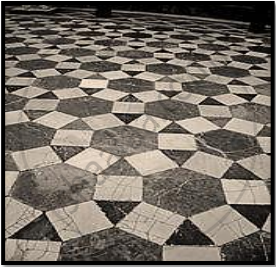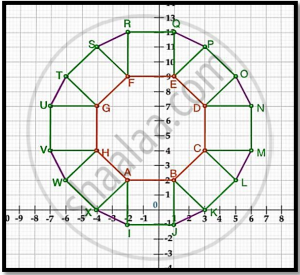Advertisements
Advertisements
Question
Let ABCD be a square of side 2a. Find the coordinates of the vertices of this square when The centre of the square is at the origin and coordinate axes are parallel to the sides AB and AD respectively.
Solution
The distance between any two adjacent vertices of a square will always be equal. This distance is nothing but the side of the square.
Here, the side of the square ‘ABCD’ is given to be ‘2a’.
Here it is said that the centre of the square is at the origin and that the sides of the square are parallel to the axes.
Moving a distance of half the side of the square in either the ‘upward’ or ‘downward’ direction and also along either the ‘right’ or ‘left’ direction will give us all the four vertices of the square.
Half the side of the given square is ‘a’.
The centre of the square is the origin and its vertices are (0, 0). Moving a distance of ‘a’ to the right as well as up will lead us to the vertex ‘A’ and it will have vertices (a, a).
Moving a distance of ‘a’ to the left as well as up will lead us to the vertex ‘B’ and it will have vertices (-(−a, a).
Moving a distance of ‘a’ to the left as well as down will lead us to the vertex ‘C’ and it will have vertices (-(−a, -−a).
Moving a distance of ‘a’ to the right as well as down will lead us to the vertex ‘D’ and it will have vertices (a,-,−a).
So, the coordinates of the different vertices of the square are
A(a, a)
B(-a, a)
C(-a, -a)
D(a, -a)
APPEARS IN
RELATED QUESTIONS
Let ABCD be a square of side 2a. Find the coordinates of the vertices of this square when A coincides with the origin and AB and AD are along OX and OY respectively.
Find the third vertex of a triangle, if two of its vertices are at (−3, 1) and (0, −2) and the centroid is at the origin.
Prove that the points (3, -2), (4, 0), (6, -3) and (5, -5) are the vertices of a parallelogram.
If three consecutive vertices of a parallelogram are (1, -2), (3, 6) and (5, 10), find its fourth vertex.
Show that the points A (1, 0), B (5, 3), C (2, 7) and D (−2, 4) are the vertices of a parallelogram.
Find the co-ordinates of the point equidistant from three given points A(5,3), B(5, -5) and C(1,- 5).
Find the area of a quadrilateral ABCD whose vertices area A(3, -1), B(9, -5) C(14, 0) and D(9, 19).
Find the area of the quadrilateral ABCD, whose vertices are A(−3, −1), B (−2, −4), C(4, − 1) and D (3, 4).
If the point \[C \left( - 1, 2 \right)\] divides internally the line segment joining the points A (2, 5) and B( x, y ) in the ratio 3 : 4 , find the value of x2 + y2 .
If A(−3, 5), B(−2, −7), C(1, −8) and D(6, 3) are the vertices of a quadrilateral ABCD, find its area.
\[A\left( 6, 1 \right) , B(8, 2) \text{ and } C(9, 4)\] are three vertices of a parallelogram ABCD . If E is the mid-point of DC , find the area of \[∆\] ADE.
If points Q and reflections of point P (−3, 4) in X and Y axes respectively, what is QR?
Write the formula for the area of the triangle having its vertices at (x1, y1), (x2, y2) and (x3, y3).
The area of the triangle formed by (a, b + c), (b, c + a) and (c, a + b)
If the line segment joining the points (3, −4), and (1, 2) is trisected at points P (a, −2) and Q \[\left( \frac{5}{3}, b \right)\] , Then,
f the coordinates of one end of a diameter of a circle are (2, 3) and the coordinates of its centre are (−2, 5), then the coordinates of the other end of the diameter are
If the perpendicular distance of a point P from the x-axis is 5 units and the foot of the perpendicular lies on the negative direction of x-axis, then the point P has ______.
Find the coordinates of the point whose ordinate is – 4 and which lies on y-axis.
A tiling or tessellation of a flat surface is the covering of a plane using one or more geometric shapes, called tiles, with no overlaps and no gaps. Historically, tessellations were used in ancient Rome and in Islamic art. You may find tessellation patterns on floors, walls, paintings etc. Shown below is a tiled floor in the archaeological Museum of Seville, made using squares, triangles and hexagons.

A craftsman thought of making a floor pattern after being inspired by the above design. To ensure accuracy in his work, he made the pattern on the Cartesian plane. He used regular octagons, squares and triangles for his floor tessellation pattern

Use the above figure to answer the questions that follow:
- What is the length of the line segment joining points B and F?
- The centre ‘Z’ of the figure will be the point of intersection of the diagonals of quadrilateral WXOP. Then what are the coordinates of Z?
- What are the coordinates of the point on y-axis equidistant from A and G?
OR
What is the area of Trapezium AFGH?
The distance of the point (–4, 3) from y-axis is ______.
